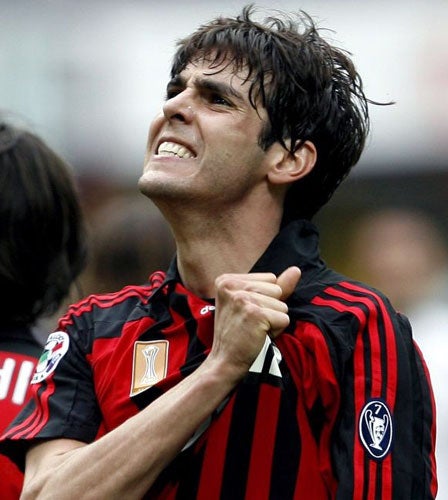Perez power and huge income fund Real's £250m spending spree
TV and kit deals coupled with President's pull at the banks explain cash mountain

Real Madrid's summer spending could reach €300m (£256m) according to the latest estimates in Spain, but how do they have so much cash? There are two reasons: huge income, and a powerful president.
Real earn more money than any club in the world. When figures from the 2008-09 season are released late this year, they will show annual income of €400m, possibly more.
A domestic TV deal worth £132m per year with broadcaster Mediapro underpins this, although Real also have massive commercial streams, sponsorship deals and matchday revenues.
Wearing adidas kit earns £81m a year in fees and spin-offs, and the online betting firm BWIN pays £18m a year (at today's exchange rate) to be Real's shirt sponsors.
Audi and Coca-Cola are among Real's other commercial partners, while corporate income on match days has increased by reconfiguring the Bernabeu (capacity 80,500) to hold more "hospitality customers".
Almost as important as the revenues, if not more so, is that Real's president is Florentino Perez, 62, one of Spain's richest self-made men. He was the president from 2000 to 2006 during the first "galactico" era at the club and has now returned to oversee the sequel.
Forbes magazine estimates Perez has a personal fortune of £1.1bn, not that he has ever needed to dip into his own pockets to pay for players. Nor does he plan to, and under Real's constitution, nor is he allowed to. Equally he is forbidden from profiting from the club.
But Perez's standing as one of Spain's wealthiest and most influential businessmen will loosen the purse strings at the local banks. No bank will want to be the one denying a line of credit. Real will have no problem borrowing money, even if their summer spree reaches £250m or more.
With Kaka already signed from Milan for £56m and Cristiano's proposed move from Manchester United worth £80m, Real are already more than half way to spending £250m. If David Villa is lured from Valencia, for around £30m-£35m, they could have spent £170m or more on three players with other targets still out there.
How do the numbers stack up? Those close to the club say that €100m was always going to be the minimum in the transfer kitty for the summer, mainly from annual profits. On top of that, Real want to sell this summer, with Dutch faces prominent on the "out" list. Arjen Robben, 25, Wesley Sneijder, 25, Rafael van der Vaart, 26, Ruud Van Nistelrooy, 32, and even the prolific Klaas-Jan Huntelaar, 25, could all go. It might not be straightforward to arrange deals at top prices, but even offloading at discounts should bring in €100m. Van Nistelrooy aside, the others have their prime years ahead.
So let us say that the kitty plus sales give Real £170m, or thereabouts, towards spending of £250m-plus. With Real's income, the balance of £80m or so required in bank loans is a relative pittance, especially when Perez is convinced – and he has historical evidence to support him – that any star signings will effectively pay for themselves.
That was his mantra in the first galactico era, and it is worth recalling how David Beckham's signing in 2003 demonstrated it. John Carlin, author and Real Madrid aficionado, knows Perez well and recounted the story of the day the Beckham deal was done in his book White Angels: Beckham, Real Madrid and the new football.
"Peanuts! They're asking peanuts," is what Real's director of marketing, Jose Angel Sanchez, said down the phone to Perez from Sardinia, where he was negotiating for Beckham with United's then chief executive, Peter Kenyon, for a maximum £22m. Perez, ever the tough businessman, wanted to knock them down more, but Sanchez assured Perez that Beckham was worth €500m in commercial income.
Beckham certainly helped transform Real's finances. Their annual income the year before he arrived was around £180m. Last season it was more than double that. They may have struggled on the pitch but Perez, who is a civil engineer by trade and who Carlin calls "the cleverest bloke in football", has helped them thrive financially.
In business, Perez bought a construction firm for one peseta in 1983 and turned it into a major international conglomerate, ACS. As Carlin wrote in White Angels: "He is hard, dry, austere, persistent, driven. You look at him and you understand a little better how a handful of his compatriots once sailed off in small wooden boats and conquered Mexico and Peru."
Who's next? On the Real hit-list
David Villa 27-year-old Valencia striker, 44 caps for Spain, 28 goals
Forward, close to finalising move.
Franck Ribery 26-year-old Bayern Munich midfielder, 37 caps for France, 7 goals
Inventive sought-after winger.
Xabi Alonso 27-year-old Liverpool midfielder, 57 caps for Spain, 4 goals
Enjoyed a fine season at Anfield.
David Silva 23-year-old Valencia midfielder, 23 caps for Spain, 3 goals
Has impressed for national team.
Raul Albiol 23-year-old Valencia defender, 13 caps for Spain, 0 goals
Will offer versatility at the back.
Subscribe to Independent Premium to bookmark this article
Want to bookmark your favourite articles and stories to read or reference later? Start your Independent Premium subscription today.

Join our commenting forum
Join thought-provoking conversations, follow other Independent readers and see their replies